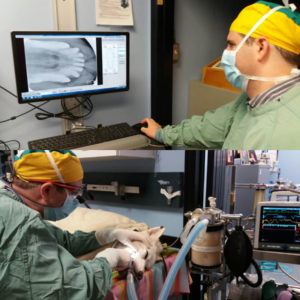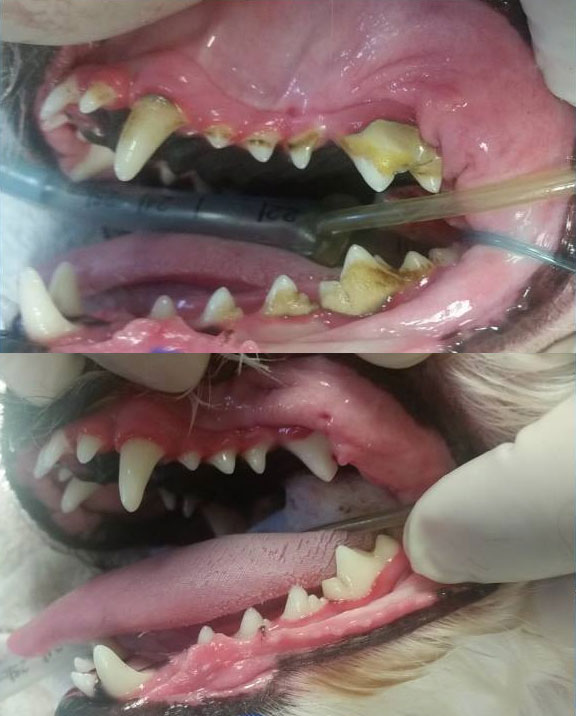Regular professional cleaning is important to maintaining your pet’s teeth.
We use modern and safe ultrasound to clean each tooth thoroughly – above and below the gum line. Our clinics have two veterinarians that provide all of our patients with dental procedures; Dr. Lima, owner of Carleton and Lanark Vet, and Dr. Wicks, an associate veterinarian. Dental technicians polish teeth to create a smooth, lustrous tooth surface more resistant to plaque build-up.
Our veterinarians recommend dental x-rays so that they can better see what is going on underneath the gum line. Poor dental health can affect other organ systems causing heart issues or other diseases. Dental x-rays help to see if periodontal disease is present and if so, at what stage.
Dental patients come into the clinic the morning of their procedure, where our veterinary technicians will do surgery prep before the patient is put under anesthetic: TPRs, blood work and x-rays before the procedure. Similar to all surgeries done in clinic, our patients are consistently monitored by a surgical technician throughout the entire dental procedure and everything is documented. Patients are monitored thoroughly throughout the day after their dental procedure by our technicians and assistants. After a final exam by our veterinarian, patients can go home that same night so that they can be with their family and in their own bed! Homework rules will be given at the time of pick-up to ensure that your pet has a healthy recovery.

Dr. Lima performing canine Dental

Bad Breath?
 Halitosis is the technical term for “Bad Breath”, but no matter what it’s called – it is not something you want your pet to have! It is one of the common complaints of pet owners in their pet’s annual check-up. It can be caused from issues with the mouth or can rally from other internal health problems.
Halitosis is the technical term for “Bad Breath”, but no matter what it’s called – it is not something you want your pet to have! It is one of the common complaints of pet owners in their pet’s annual check-up. It can be caused from issues with the mouth or can rally from other internal health problems.
What can cause this, specifically?
The most common cause is Periodontal Disease, which is caused by plaque. The bacteria in the plaque are attracted to the tooth surface just within hours of teeth being cleaned. In just days, it becomes mineralized which produces what we call, calculus. As this progress, gingivitis occurs and then develops into periodontitis (bone loss). Just from that the bacteria changes from being irritating and turns into something that destroys the bone and produces hydrogen sulfide, thus causing, bad breath! Of course there are many other causes of bad breath, make sure to ask your Veterinarian if you have any concerns!
Are there signs other than bad breath?
Some dogs and cats will have problems chewing hard food, others will paw at their mouths. Though periodontal disease is painful, unfortunately most will not show any signs of discomfort.
How do you diagnose and treat the cause?
A Veterinarian needs to diagnose the cause of the bad breath by having your pet brought in for a consultation. If an oral exam cannot determine the cause of the odor, then bloodwork and/or dental x-rays may need to be done.
Treatment of the odor depends specifically on the cause. With periodontal disease, there are four stages:
- Stage one and two are early and advanced gingivitis which can be treated with professional teeth cleaning.
- Stage three and four is where the disease progresses and bone loss occurs. This could mean surgery and/or tooth extractions need to be performed.
What do you suggest?
We take oral health seriously and we understand that it can be hard for owners to find time or even remember to care for their pet’s teeth on a regular basis. At both locations we have Veterinarians that can help you choose the appropriate diets and treats for your pet to assist regular brushing of your pet’s teeth and to promote great oral health care and disease prevention.
We can also recommend pet insurance to give you peace of mind in knowing that if something was to happen – your pet would receive the best care with us!
How do I brush my pet’s teeth?
 Start with getting a toothbrush and tooth paste from you Veterinary Clinic:
Start with getting a toothbrush and tooth paste from you Veterinary Clinic:
- Fine bristle for large dog.
- Finger toothbrush for small dogs and cats.
- Make sure to not use human toothpaste as it has ingredients that should not be swallowed!
Next Step, you may need a second pair of hands if you are just starting this routine!
- Hold the lips up so that you can see the teeth.
- Brush only in circular motions on the teeth and downwards when brushing between the gum line and teeth to prevent excessive irritation to the gums.
- Continue this throughout the teeth – no need for a ‘Rinse & Spit’ though it may make for a neat party trick!
You should start brushing your pet’s teeth once the teeth grow through the gums. This gets them used to the procedure and helps prevent bacteria from going below the gum line. You should inspect your pet’s mouth on a monthly basis, looking for dark yellow and/or brown build-up. Once there is a build-up of plaque that cannot come off with brushing, it is time for a professional cleaning by a Veterinarian.


